DIGESTIVE SYSTEM
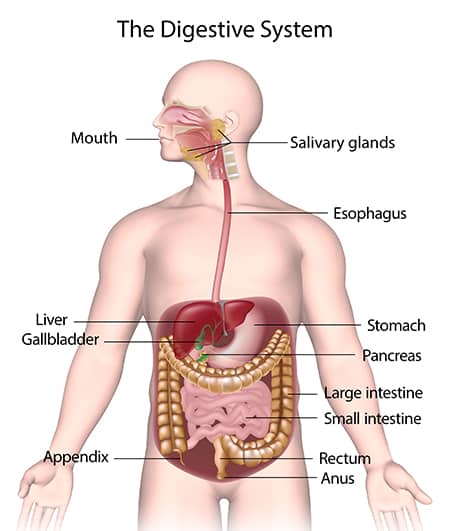
The digestive system is a system where your food goes through. It begins with you eating your food, which goes through your mouth. Saliva contains something called enzyme which breaks down your food. The food then goes down the Oesophagus, a tube that runs from your mouth, all the way to your stomach. Your stomach creates a mixture of acids and enzyme, so the food can be digested. The small intestine is a 7.6-meter tube that connect from the small intestine to the large intestine. The stomach stores food in its body for 3 hours, before it begins to digest and drop into the duodenum.
The duodenum is the first, and shorted part of the small intestine. It is a 25-30cm ‘C’ shaped tube. The gall bladder, liver and pancreas all connect to the duodenum by a tube which transports liquid to help the duodenum digest food. After it has finished digesting it will go into the large intestine, after which it comes out the Anus. Some diseases consist of Gastroesophageal Reflux, gallstones, and celiac disease. Gastroesophageal reflux is a disease that happens to both male and female. It is a disease that can cause heart burn or acid indigestion. Heart burn/acid indigestion is pain in the oesophagus, because stomach acid is rising into the oesophagus. After effects can be things like, chest pain, chronic cough etc.
RESPIRATORY SYSTEM
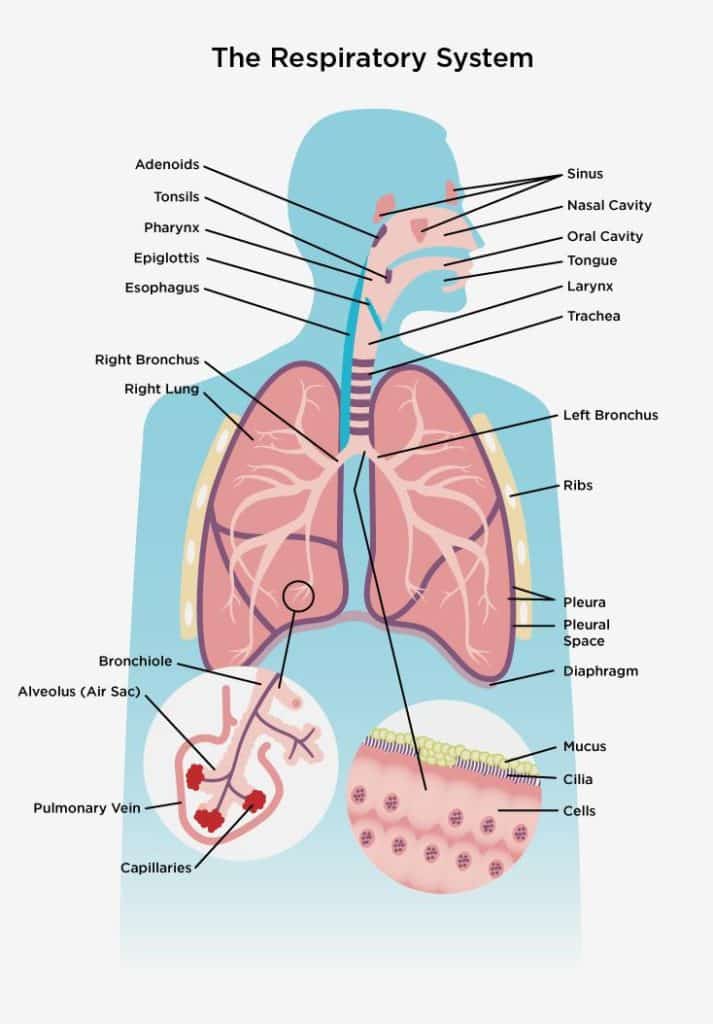
The respiratory system is a system which is responsible for your breathing. The system’s main organ is the lungs, which takes in oxygen while we inhale and lets out carbon dioxide when we exhale.
Your voice box is also an important part of this system, for without this system, you wouldn’t be able to talk. The voice box, or larynx, is 2 inches long, and has vocal cords, which are two bands of muscle that form a ‘V’ inside the voice box. Every time we breathe in, air goes into our oral cavity, or our nasal cavity, then through the pharynx, into the larynx, down the trachea and into the bronchus, which takes air into the lungs. When we breathe out, the air goes the other way. When we breathe out, the vocal cords ‘relax’ and air moves in-between the muscles without making a sound. But when we talk, the muscles tighten, so air from the lungs gets forced in-between the muscles, which makes them vibrate. The tongue, lips and teeth form this vibration into sound, which are the words we speak.
Some common diseases in the respiratory system are as follows:
Asthma – Asthma is where a person’s airway becomes inflamed and squeezes together, making it very hard to breathe. While your airway is inflamed, your body produces a lot more mucus.
obstructive pulmonary disease (COPD) – COPD is a disease where a person is becoming short of breath, or the inability to exhale normally. COPD can be caused by smoking, or even secondary smoking.
CIRCULATORY SYSTEM
The respiratory system and the circulatory system’s jobs over lap quite a bit. The respiratory system need to get oxygen into your lungs, while the circulatory system’s job is to transport the oxygen and nutrients around your body. Without your circulatory system, your body would not be able to fight of diseases.
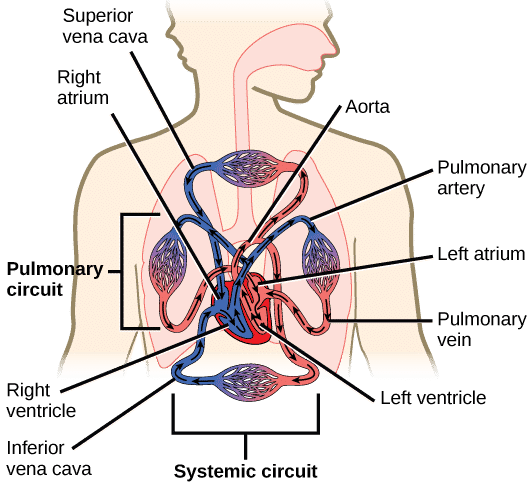
The circulatory system ‘starts’ at the heart. The heart is one of the most important body parts in your body. Without your heats pumping, you would die.
Your heart pumps your blood cells and pushes them to your lungs. While at your lungs, oxygen attaches to your blood cells through haemoglobin, so that they can go to the other parts of your body. After the lungs, your cells go back to the heart, so they can be repumped for more speed. The cells are taken through the aorta, the largest vein in your body, and then sent to your different body parts that need oxygen through more veins. Your body has more than 100,000km of blood vessels, and your cells cart oxygen throughout all the vessels.
Once oxygen has been delivered, the cells then begin to get carbon dioxide sticking to them. The cells go all the way back to the heart, which pumps the cells full of carbon dioxide back to the lungs, and then the lungs exhale the carbon out of your lungs. At the same time, the blood cells pick up oxygen, and do the whole trip again.
Some diseases of the circulatory system can be: High blood pressure, Coronary artery disease, and stroke.
Coronary artery disease – This is when plague clots up in your artery, allowing less blood to the rest of your body.
Stroke – This is when you have a loss of blood to your head, and the side of your head droops.
EXCRETORY SYSTEM
The excretory system is a system that filters through all your blood. When you eat, your body digests that food, and lets it ‘sit’ in the stomach for around 3 hours. The food then goes into your small intestine. The food has its nutrients taken from it in the small intestine. The food then goes down the large intestine, or the food goes into your bloodstream from the small intestine.
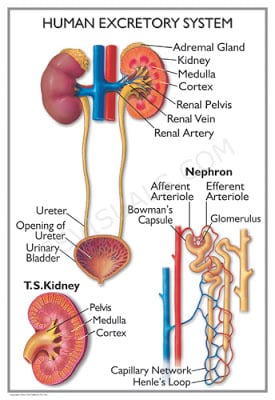
You would probably get very sick if you didn’t have kidneys. Your kidneys are one of the most important pieces of your excretory system. Your blood is filtered by your kidneys, which allows your blood to go through your body at the perfect thickness, and with the perfect amount of nutrients in the food. Your blood arrives at the kidneys through the renal artery, which splits into many different arterioles. The arterioles take the blood to many different filters. Blood is filtered by pressure.
Your urine waste is transported to your body’s only urinary bladder via ureters. Your urinary bladder expands and sends nerve warnings to your brain when it is full.
Some diseases in the excretory system are:
Kidney stones – This is where there is a build-up of minerals and acid salts in your ureters. The stones usually go down your ureters, into your bladder, until you urinate.
Kidney/renal failure: In this situation, your kidneys lose the ability to remove waste and to balance fluids.
SKELETAL SYSTEM
The skeletal system is a system that makes up your bones. An adult body has around 206 bones. The 206 bones are split into two groups: a hard bone and a soft bone, called cortical and trabecular. Your bones are made from collagen, which is a protein that makes up a framework for our bones. When you are born, your bodies have around 300 bones, although some fuse together while growing up. Your bones meet at points called joints, which allows movement between the bones they connect. Your bones store calcium, which is very important to the working of nerves and muscles. The bones also contain bone marrow, which makes blood cells.
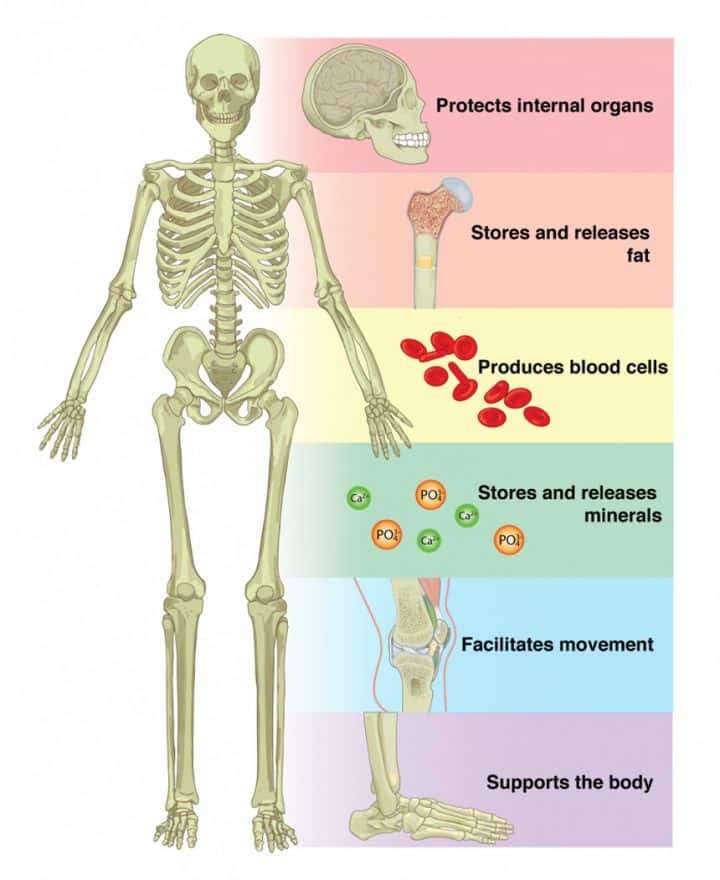
A highly flexible structure called the vertebral column supports the head and body. It also helps protect the tissues of the spinal cord. The spinal cord is made up of 33 bones called the vertebrae, the bones are separated by something called intervertebral discs, which act as shock absorbers. The bones of your spine are kept in place by muscles and ligaments. Your bones are very light, although they are around five times stronger than steel.
Some common diseases in the skeletal system are:
Arthritis – This is where your joints are inflamed, causing pain and stiffness in the joints. This disease cannot be cured, although treatment can help calm the pain.
Osteoporosis – A disease in which your bones become very weak; your body constantly absorbs and replaces bone tissue, with this disease, your body cannot keep up with replacing the tissue, and your body ends up with less tissue inside of it.
